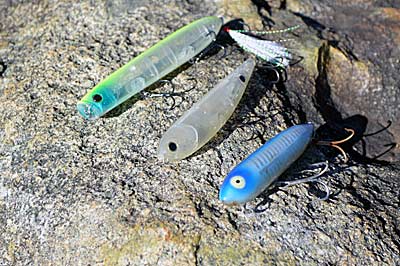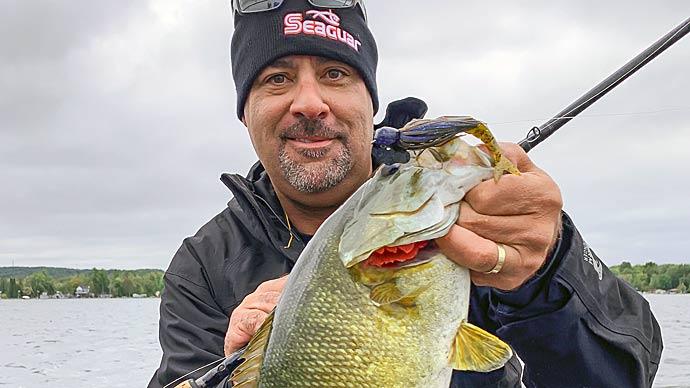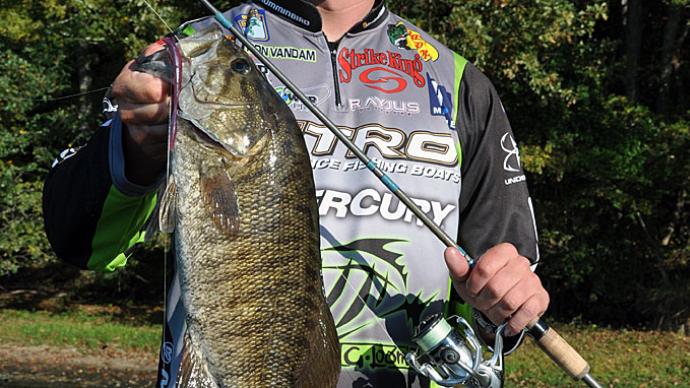
Modern smallmouth fishing is all about looking down. The most popular lures — Ned rigs, drop shots, and tubes — are fished along the bottom, where constant contact is the deal. And the relatively recent explosion of forward-facing sonar, which provides a live view of bass and bait, is giving bass anglers one more reason to keep their heads down.
But down isn’t the only direction to go to catch big smallmouth. Look up, and you’ll see plenty of options. These lures help you cover more water in less time and require less precision, whether casting or controlling your boat. And they can be more fun. Sure, a smallmouth hooked on a drop shot, for example, can make powerful turns and an occasional leap. But you miss out on watching them hunt a lure ripped through clear water, feeling the arm-jarring strikes, and watching the midair acrobatics that are almost guaranteed to follow.
Bottom-bouncing presentations aren’t going away. And they shouldn’t. They are valuable tools for catching smallmouth, especially under challenging conditions. But there will always be days when it’s more fun to put them down and fish a lure that catches them looking up. If that’s today, here are five to try.
Topwater
Every bass angler enjoys fishing topwater lures. But they’re even better when you add smallmouth to the mix.
Topwaters are available in various styles, from small single prop baits, such as Heddon's Tiny Torpedo, to giant walking ones, such as Heddon's Super Spook. But when it comes to calling up smallmouth, bigger lures are better. It creates a significant disturbance, allowing smallmouth to hone in on its location and, more importantly, its direction.
You’ll find topwater action by fishing shallow water on most days. Rock piles, points, and scattered clumps of aquatic vegetation are good spots to seek out. But don’t limit your topwater fishing to shallow water. These lures can draw smallmouth from shoals, humps, and the end of points in deep water — 20, 30, or more feet — as long as the water is clear and its surface relatively calm. Flat water isn’t required for fishing topwaters in shallow water. Smallmouths will exit a wave’s side to eat one.
Shallow or deep, cast your topwaters on a rod that has a moderate action, like one you would use for crankbaits. It’s flex, which goes from tip to handle, acts like a shock absorber, keeping bass hooked on trebles. It makes working them easier, too. And remember to use monofilament line, sized to conditions. Unlike fluorocarbon, it floats. That keeps your lure where it’s supposed to be, on top of the water.
Spinnerbait
Smallmouths and spinnerbaits are a classic combination. Whirling blades, pulsating skirts, and a steady pace create an irresistible target that is easy to find in various conditions. Those include the darkest hours of the night, when many reservoir-run smallmouth fall victim to short-arm spinnerbaits dropped along steep bluffs, or a river backwater when winter’s grip loosens, and bass seek spawning spots and a lightweight spinnerbait sporting a pair of small Indiana, or Colorado blades catches its share.
Image
Ripped just under the surface, double-willow spinnerbaits are a longtime favorite of smallmouth anglers. The best ones have blades that produce lift without creating too much drag. Photo by Pete M. Anderson But when it comes to naming the all-star spinnerbait for smallmouths, the double willow takes center stage. Weighing at least ½ ounce, it creates a large profile that’s easy for smallmouth to find and chase down, especially in clear water. If the conditions are relatively calm and the water shallow, you can watch smallmouth turn to chase down your spinnerbait, leaving a tell-tale swirl on the surface.
While these spinnerbaits can be slow-rolled, they shine when you rip them just below the surface. A speedy retrieve gives smallmouth less time to investigate, forcing them into a reaction strike. Keeping it in that zone requires perfectly matched willow-leaf blades — No. 4 and No. 4.5. They create enough lift to keep your spinnerbait near the surface but not enough drag to slow it down.
Fan casting is a productive approach. But aiming them along critical cover and structure is essential. Look for edges and clumps of aquatic vegetation to bring your spinnerbait along or across. Shallow ledges are also essential, as are places where bottom composition changes, such as sand to rock. Even a mud line, such as where waves crash into a sand or mud bank, can create an edge for smallmouth.
Outfit your double-willow spinnerbait with baitfish-pattern skirts and metallic blades, though painted ones can be productive on overcast days. Don’t be timid with the gear you use to cast them. You’ll want a heavy power and fast action baitcasting rod matched with a high-speed reel — at least 7:1 gear ratio — spooled with 15- or 17-pound test monofilament or fluorocarbon line.
Jerkbaits
Erratic action triggers smallmouth, especially when you want them to eat your moving lure. Few baits bring more of that to the table than jerkbaits, especially the soft and floating varieties. While suspending jerkbaits have plenty of erratic action, they are often fished slower and deeper, while the other two types are fished just below the surface.
Floating jerkbaits come in a variety of sizes and colors. But they all share a similar slender profile, often called the most realistic, and a short-rounded bill. It bites into the water with each twitch, causing the jerkbait to dive and wiggle. Speed is an important variable once again. They should be fished with a quick succession of rod tip twitches and reel handle cranks. Those get your jerkbait moving down, left, and right. Slight periodic pauses in your retrieve add one direction — up. They also create plenty of noise, especially plastic ones filled with rattles. Their treble hooks make noise as they rattle against split rings and the jerkbait's body.
Some days you’ll need a lure with all the action but little of the noise of a floating jerkbait. So, turn to a soft-plastic version, such as Zoom’s Super Fluke, when conditions are tough. They sink slowly and move quietly through the water. They also are a better choice when fishing for smallmouth around aquatic vegetation. There's little chance of snagging with a single hook rigged Texas style. The same can’t be said for floating jerkbaits, which sport at least a pair of exposed treble hooks.
Rig your soft-plastic jerkbaits with a small bullet weight, which increases castability and action. Or try a small barrel swivel a few feet up the line. It adds weight, as aforementioned, and removes line twist, which eventually becomes a nightmare, especially with spinning reels, when you are fishing a soft jerkbait.
Lipless Crankbait
Like erratic action and speed, sound triggers smallmouth, too. Lipless crankbaits, such as a Bill Lewis Rat-L-Trap, have all those traits. And that has made it a longtime favorite of smallmouth anglers.
Lipless crankbaits are filled with rattles, so you can hear the lure coming through the water. Built without a diving lip, running depth is determined by retrieve — how long you wait to start, speed, and number and length of pauses. While there is no wrong way to fish one, two retrieves are best for pulling up smallmouth.
Image
Crankbaits aren’t usually a top-of-mind choice for catching smallmouth. But small square-bill ones can be effective when bounced through laydowns in a river or across shallow rocky flats dotted with aquatic vegetation in lakes. Photo by Pete M. Anderson The first retrieve is simple: steadily towing a lipless crankbait at a brisk clip. It creates a target that’s easy for smallmouth to track and find in various conditions. It’s a rare day that you can reel it too fast, making it perfect for covering vast shallow-water flats. But remember to hold your rod’s tip high to keep yours running high in the water column.
The second retrieve is a pull and pause. Using your rod, pull your lure forward fast enough to feel it vibrate. Then follow it back down with your rod tip, letting it glide on a semi-slack line. It works best when the water temperature is in the 50s, in spring or fall.
The most popular size of lipless crankbait is ½ ounce. It works in nearly every situation. Choosing a color is just as easy. Natural patterns that feature a splash of chartreuse, yellow or orange work almost everywhere and anytime. They seem to set off a smallmouth’s aggressive nature.
Choose a rod at least 7 feet long, which will help you cast further. It should have a moderate action, which will help keep jumping and thrashing smallmouth hooked, and a medium-heavy power, which will help you work your lipless crankbait. While the first retrieve can be fished with any line, try fishing the second on braided line. Its lack of stretch makes it easy to “pop” yours free when it catches on aquatic vegetation while gliding.
Square Bill Crankbait
Every bass angler knows that the shape of a crankbait's bill dictates diving depth. The longer its length, the deeper it dives. But the shape also contributes to its action. Rounded bills, for example, cause crankbaits to wobble and hunt when ground along the bottom. On the other hand, square bills create a shaking action that wants to plow through cover. They also limit diving depth, keeping your crankbait high in the water column and often within your view.
Small square bill crankbaits dig slightly deeper than a spinnerbait or floating jerkbait and can be paused, unlike a lipless crankbait, are built for chasing smallmouth in rivers. They will bounce their way through laydowns and along rip-rap banks, both key smallmouth-holding spots much of the year. But don’t discount them when you head to your favorite smallmouth lake or reservoir. Bouncing one around clumps of aquatic vegetation on a shallow flat or across a windblown shoal or point can be productive.
Match your crankbait's color to the predominant forage and water color. For example, lean toward perch patterns if you’re hunting smallmouth in a natural lake. That includes the gaudy fire tiger, which is a good choice when the water is stained or churned by waves. And if you replace hooks, resist the urge to choose a larger size. While that strategy often results in better hookups in more open water, it can lead to more snags when fishing in and around cover.
These crankbaits need a more powerful rod and stronger line than your usual off-shore cranking outfit. So while you’ll still need a moderate action rod, choose one with a heavy power. Combined with 15- to 17-pound test monofilament or fluorocarbon, it will give you more control over these powerful bass. And the line’s large diameter creates more resistance in the water, forcing your crankbait to run shallower.




